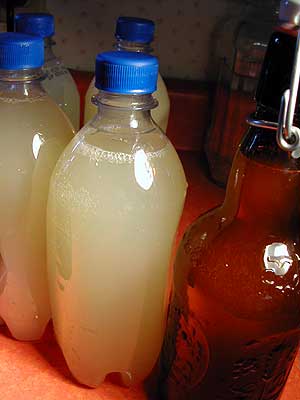Making Ginger Beer
Bottled and Waiting

Bottles filled & starting to build CO2 pressure
Wipe off the bottles and set them in a warm place again. Warm temperatures make the yeast act faster, so a cool 55 degree fahrenheit room might take twice as long as an 80 degree room. In a sixty five degree room it takes about twelve to fifteen hours for the bottles to build up good pressure. To be on the safe side you might want to put them into a plastic bucket or other type of waterproof container to catch any leaks. You can also wear safety glasses and leather gloves when handling them just to be sure.
Keep an eye on your test bottle to see how long before it expands to its normal shape. Squeeze the bottles from time to time to gauge how tight the plastic is and thus how much pressure is building. On my first batch I didn't know what to expect and was nervous the whole time. Now that I have done this a half dozen times I have a pretty good feel for how long it takes and how tight these bottles can get.

When you can't take the pressure anymore (hah, hah) put the bottles into the refrigerator. The cold temperature of the fridge will eventually halt the fermentation. Remember, it is only halted, not stopped for good.
If you left a bottle out it will most likely start fermentation again and not stop until it blows up or consumes all of the sugar. Blowing up is most likely. Depending on your fridge it may also continue to ferment very slowly inside, so don't leave bottles unattended while you go away on vacation.
Typically we start ginger beer around mid-day and within a few hours we bottle it, which is late afternoon. The bottles are left out overnight to build pressure and put in the fridge the next morning.
For your first batch you might want to start early in the morning so you can finish up and put them in the fridge before going to bed.
| «Bubble Machine | Page 4 of 8 | New Recipe» |
